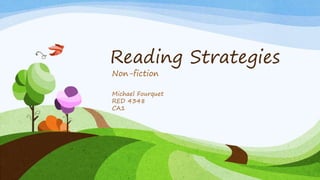
Boost Non-Fiction Reading with BDA Strategies
- 2. Welcome to the Reading Road! Follow this path and you will find useful strategies to use to help you with non-fiction reading! Some strategies are for before you read, to help you get ready. Some are for during reading, to help you understand. And finally, some are for after you read, to help review and check understanding.
- 3. Before Reading There are things you can do before you even start reading to help you understand what you are about to read.
- 4. Scan the Text Read the title and headings – They will usually give you a good idea what you are going to read about. Look at the pictures, illustrations, graphs and charts – This will likely serve as a visual representation of what the text says, and will help you predict what it is about. Take note of any bold or italicized vocabulary words
- 5. Consider the Purpose of Reading Why are you reading the text? Information? Instruction? Persuasion? Consider the purpose of the text, because it will help you process the information! If you are reading to learn how do something, you will be looking for different information than you would for a historical account.
- 6. Make Predictions Look back at the information you gathered while scanning the text. What do you think the selection is going to be about? Why?
- 7. Activate Prior Knowledge Ask yourself, “What do I already know about this topic?” Where have you learned about this topic before? Does it remind you of anything else you have read in the past?
- 8. Prewrite Questions Write questions that you think the text is going to answer. Write questions that you think the teacher may ask to check comprehension.
- 9. During Reading Now that you are ready to read, let’s look at a few ways to help you understand what you’re reading.
- 10. Self-monitoring While reading, think about the information you are reading. Ask yourself if it makes sense. If not, try rereading confusing parts, and use context clues to help clarify.
- 11. Text Rendering Write on the text selection to create a direct interaction with the reading. (If you are not allowed to write on the paper, use sticky notes) Make a check mark () next to statements you understand or agree with. Write a question mark (?) next to statements that confuse you. Write an exclamation point (!) next to or highlight main ideas and important details. Later you can look back to see the important information, and where you need help.
- 12. Answer Questions Remember the questions you wrote before you started reading? Now is the time to find the answers to the question you thought the text was going to answer, and the questions you thought the teacher may ask after reading. If you cannot find an answer after reading, and reviewing, evaluate if the question is relevant to the text.
- 13. Visualization Using the words you are reading, illustrations provided, and your imagination, create a picture in your mind of the people, places, and events you are reading about. What do you see?
- 14. Reread No, no, no. You don’t have to reread the whole thing! Reread key points, and information that can answer questions, support opinions. Look for titles, section heading, and bold or italicized words.
- 15. After Reading You are done reading, so now what? Let’s look at some strategies you can use to really pull it all together!
- 16. Summarize Think back on what you just read. In your own words, explain what the author is trying to communicate. Does your summery make sense? What is the main idea? If you are confused, are missing the main idea, try rereading the section.
- 17. Outline the Text Like summarizing, list the main ideas of the text. This time, go back and reread through the selection, and add supporting details to each main idea. Outlines are great to refer back to when completing other assignments or studying for a test.
- 18. Reflection Write about what you just read. What was the reason the author wrote it? What did you learn? Did any of the information surprise you? Did it remind you of any other reading you have done? How does it relate to you personally?
- 19. Generate Questions Just like before reading, write questions about the text. This time, write questions you think the teacher may ask, or that may be on a test, based on the main ideas and key details you found while reading. If you cannot answer them, go back to the selection, and find the answers. How are you new questions different? How are they similar?
- 20. Share Your Learning Present what you have learned to others. There are many ways to do this, such as speaking about the topic, writing about it, or creating a visual representation.
- 21. References BEFORE-DURING-AFTER (BDA) Reading Strategies. (n.d.). Retrieved November 18, 2015, from https://moodle.org/pluginfile.php/409/mod_forum/attachment/977655/before ,during ,after reading strategies.doc Bursuck, W., & Damer, M. (2011). Teaching reading to students who are at risk or have disabilities: A multi-tier approach (2nd ed.). Upper Saddle River, N.J.: Pearson.